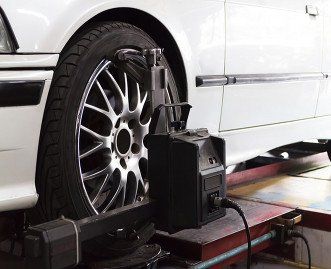The go-to Garage in Wirral
Professional tyre servicing, for a smooth drive
Know your Tyres
A very vital aspect of road safety and vehicle maintenance is knowing the state of your tyres at all times. It is extremely useful and advisable to carry out regular inspections on your car's tyres to check for the suitability of tread depth, tyre pressure, lumps, bulges and any other damage to the tyre. Maintaining optimum tyre pressure leads to optimum fuel efficiency.
Tyre Safety
It is important to visually check the condition of tyres on a regular basis.
- Lumps and bulges may indicate the tyre has been damaged internally
- Any cuts to the tyre, if it is deep enough, could leave the tyre unsafe
- Tyres deteriorate with age and if cracking is present it may indicate that the rubber is perished and the structural integrity can't be assured
If you notice any of these signs or have any concerns about the safety of your tyres then you should get them checked by an experienced and knowledgeable tyre expert (i.e. us!), and if there are any serious doubt replace the tyre with your spare until you are able to get it checked.
Tread Depth
- All tread depths including the spare must be greater than the legal minimum limit of 1.6mm in a continuous band throughout the central ¾ of the tread width, and across the entire circumference of the tyre
- Tyre grip diminishes progressively with wear and as a consequence stopping distances increase - especially in the wet
It is important to maintain an adequate safety margin, we support the advice given by road safety organisations including RoadSafe and leading European car manufacturers who recommend replacing tyres when the tread depth reaches 3.0mm.
Tyre Pressure
The recommended tyre pressures for your vehicle will be found in the vehicle handbook or on a placard mounted on the vehicle e.g. behind the petrol filler cap or on the driverside door pillar.
Always check pressures when the tyres are cold and never adjust tyre pressures during or immediately following a journey.
Low tyre pressure can lead to;
- Structural damage due to overheating
- Increased vehicle fuel consumption
- A reduction in grip
- Irregular and premature wear of the tyre
Excessive tyre pressure can lead to;
- Increased chance of a blow-out
- Excessive wear on the centre of the tread
- Less comfortable driving experience



Wheel Alignment
The modern car is built for comfort, performance and handling. In order to achieve and maintain the best ride possible, the steering and suspension needs to be measured and adjusted. Incorrect alignment can result in rapid irregular tyre wear and can even affect the handling and safety of the vehicle.
The direction and angle at which tyres are set are both important. Wheel alignment or 'tracking' involves checking the direction and angle against vehicle manufacturers' specifications.
Tracking and wheel alignment should be checked at regular intervals. Poor alignment and tracking causes irregular and rapid tyre wear resulting in the need to replace tyres more frequently.
Wheel alignment can be affected by
- Driving against a kerb
- Bumping up onto a kerb when parking
- Hitting a pothole in the road
- Excessive wear to steering or suspension components
What are the benefits of wheel alignment?
- Reduced tyre wear
- Improved fuel consumption
- Saves money
- Improved handling and safer driving
- Alignment of wheels and tyres to the specification required by your vehicle is an important way to guarantee a smooth ride and to get the most out of your tyres.
What are the signs of poor alignment?
It is not always obvious, especially if the misalignment is slight, but there are signs to look out for:
- Uneven tyre wear on the tyres
- The car pulls to the left or right when driving
When should I have the alignment be checked?
As a general rule is every 12,000 to 15,000 miles, or at least once a year
However, it is also highly recommended when
- You notice any of the signs listed above
- Have new tyres are fitted
- Steering and suspension components are replaced
- The vehicle has been involved in any form of accident or collision

